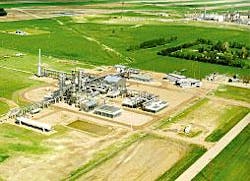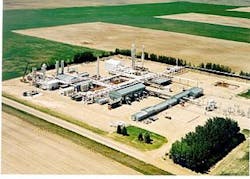Alberta gas processing shows significant development
Alberta straddle plants are some of the largest gas processing plants in North America (Fig. 1). They are called "straddle" plants because they are located adjacent to, or straddling, major gas pipeline systems.
A look into the past, in this first of four articles on the gas processing phenomenon of straddle plants, shows that Albertan gas processing has been shaped by many factors including a shifting price basis, development of the petrochemical industry, and technological developments.
Part 2, next week, will examine the outlook for these Canadian facilities.
A third article will focus on the straddle plants that process Alberta gas in the market with onsite fractionation. That article will examine how the Aux Sable Liquid Products plant, 50 miles southwest of Chicago, has affected the upper US Midwest propane market and provided access to new markets.
Part 4 will show an example of a straddle plant built outside North America to deliver LPG to a market center remote from the source of production.
Historical perspective
The first Alberta straddle plants recovered propane plus (C3+) NGL. Major Alberta straddle plants are at Empress, adjacent to the Nova-TransCanada pipeline system near the Alberta-Saskatchewan border, and at Cochrane on the (formerly) Nova pipeline system just west of Calgary.
Gas flowing through Empress moves to domestic and export markets east of Alberta, while gas flowing through Cochrane is destined for markets in California and the Pacific Northwest.
Smaller straddle plants in Edmonton and Fort Saskatchewan are on pipeline systems that serve the intra-Alberta gas market.
BP Canada Energy Co. runs a straddle plant at Edmonton that has operated for more than 30 years.
In a sense, operating these straddle plants was discretionary because the gas had already met pipeline-quality specifications. Initially, the economics in some of these facilities were based on volumetric shrinkage.
During the 1970s, however, the pricing basis for Alberta gas shifted to a thermal basis from a volumetric basis.
Shrinkage costs and processing costs therefore shifted to a thermal or btu shrinkage instead of volumetric shrinkage.
The development of the Alberta petrochemical industry during the late 1970s created the opportunity for ethane recovery.
By the late 1970s, gas to the Empress straddle plants was relatively lean. Table 1 shows a typical gas analysis and product recovery in an efficient Empress straddle plant.
Lean Empress gas quality and operators' need to recover ethane favor the turboexpander process. The second Empress straddle plant (Dome Empress I), which came on stream in 1973, is based on a turboexpander process. Dome Empress I is now the first train in the BP Canada Energy Empress complex (Table 2).
In the late 1970s, Petro-Canada's Empress, Alberta Natural Gas Co.'s Cochrane, and Dome Petroleum Ltd.'s Edmonton straddle plants—originally based on refrigerated lean oil or other processes—were refurbished and modernized with turboexpander processes that recovered ethane.
During this period, the Dome Empress I plant owners negotiated an ethane sale based on a deemed investment.
Cost-of-service-based contracts from ethane buyers justified the new capital investments in ethane recovery for the straddle plants. In these contracts, operating costs were allocated to ethane and C3+ streams.
Alberta ethane was segregated as a separate product, which was transported in the Alberta ethane gathering system (AEGS). All the straddle plants therefore had demethanizers and de-ethanizers.
The industry practice in Alberta deviated from the US where most ethane was recovered and moved in ethane plus (C2+) mixes.
For this reason, there was no immediate need to modify the central fractionators in Alberta to handle C2+ streams (OGJ, Oct. 7, 2002, p. 54).
In the early 1980s, Empress gas throughput increased when the Foothills and Northern Border pipelines were built. BP Canada Energy built the Dome Empress II plant because Alberta ethane requirements were expanding to meet the feedstock requirements of a second ethylene plant.
Economics of the Dome Empress II plant were viable based on C3+ recovery only, but the owners also negotiated an agreement to sell the ethane stream on a contractual cost-of-service basis.
The Dome Empress II plant is the second train of BP Canada Energy's Empress complex (Table 2). In the early 1980s, a third Empress straddle plant was built to process gas being exported by Progas Ltd., a subsidiary of what is now BP PLC.
Table 2 lists this plant as the EGLJV plant (Fig. 2). EGLJV owners are Altagas Liquids Inc., ATCO Midstream Ltd., BP Canada Resources Co., BP Canada Energy, Devon Canada Corp., EnCana Gas Liquids Ltd., ExxonMobil Oil Canada, Imperial Oil Resources Ltd., Nexen Marketing, Shell Canada Ltd., and Talisman Energy Inc.
NGL logistics
Ethane from the straddle plants moves through AEGS to the Nova Chemical Corp. ethylene complex at Joffre in Central Alberta and the Dow Chemical Canada Inc. ethylene plant at Fort Saskatchewan.
AEGS also has connections with Edmonton and Fort Saskatchewan, which allows the export of ethane surplus to Alberta petrochemical requirements via the Cochin pipeline.
Fig. 3 shows these pipeline systems.
Unlike other straddle plants, the Conoco Canada Ltd. Empress plant has on site fractionation for C3+, which includes a butane splitter. It also has a pipeline system that moves specification propane to markets in Western Canada and for export from Fort Whyte near Winnipeg. There is also a rail terminal at the Empress facility.
Some of the C3+ from the Conoco Canada Empress straddle plant and most the C3+ recovered at Cochrane, Edmonton, and other Empress plants have access to the Sarnia market through the Sarnia NGL system currently operated by BP Canada Energy.
Empress plants connect to Kerrobert, Sask., via the Kerrobert pipeline and to Sarnia, Ont., via the Enbridge system.
The Edmonton and Cochrane plants connect to Fort Saskatchewan, Alta., via the Co-Ed pipeline and to Sarnia via the Enbridge system.
NGL recovery
Table 2 shows the capacity of the Empress straddle plants. The owners generally refer to the BP Canada Empress 3 process train as Empress V because the investment was the fifth major investment at this complex.
Table 3 shows NGL recovery at Alberta straddle plants.1 2
In 2000, straddle-plant ethane recovery was 62.7% of total Alberta ethane recovery.
For propane, butane, and pentanes plus (C5+) recovery, Alberta straddle plants contributed 42.6%, 29.0%, and 7.4%, respectively.3
Alberta straddle plants are the dominant suppliers of ethane and are a major source of propane and butane.
The volume of gas available for processing, the liquefiable gas constituents, and the presence of contaminants such as carbon dioxide affect the recovery of ethane and other NGL.
BP Energy Canada and TransCanada Midstream decided to build Empress 3 due to the expected gas availability at Empress. Williams Canada subsequently acquired TransCanada Midstream.
The additional Empress 3 capacity exacerbated the excess straddle-plant capacity situation at Empress, which was competitive for several years. Higher shrinkage costs and relatively weak NGL prices have reduced the gross margin on propane recovery in Alberta (Fig 4).
The gross margin is the product price minus transportation and fractionation (T&F) and shrinkage costs. Fig. 4 indicates that there have been high margins on propane recovery in Alberta, particularly during 1996-98, in 2000, and August-October 2001.
Since November 2001, the gross margin on propane recovery in Alberta has been relatively low or negative. Escalating electricity costs and higher CO2 content in the gas transported in Alberta gas pipelines adversely affected the economics of ethane and NGL recovery at most straddle plants.
Pricing gas, oil, NGL
Oil and gas prices are important to oil and gas exploration companies and energy consumers.
Historically, the US government controlled gas prices in the US; but these controls were eliminated with deregulation.
During the past 30 years, oil prices have had volatile periods. Despite this, NGL prices have generally tracked oil prices. NGL demand and prices in the winter are also sensitive to weather; the 2001-02 winter was warmer than normal.
North America has also been experiencing an economic downturn and lower petrochemical demand.
Although NGL prices have tracked oil prices, the warmer weather and low petrochemical demand have contributed to lower-than-normal ethane and propane prices.
This market situation has depressed processing margins for NGL recovery.
Fig. 5 shows that there has been a modest decline in the ratio of propane price vs. West Texas Intermediate (WTI) crude price, which is attributable to the economic downturn and lower petrochemical demand.
For propane, this decline has been exacerbated by the relatively warm winter in 2001-02.
The price of gas relative to oil has fluctuated dramatically over the past 2 years.
Fig. 6 shows that processing margins have been squeezed by high gas prices and low NGL prices. Propane margins in 2001 were generally lower than in 1999 and 2000.
Except for January and February 2001, the margins were within historical ranges.
US ethane prices tend to be market responsive, but they tend to have a floor price set by shrinkage costs and T&F costs.
In regions where ethane prices fall below this floor price, the processing industry generally changes its mode of operation and some plants will reject ethane or reduce its recovery levels.
This is a simple supply response to lower prices.
Fig. 7 shows the gross margin for US Gulf Coast ethane recovery. This calculation includes a deduction for shrinkage costs and T&F. The ethane margin was lower in 2001 than during 1999 and 2000 but was generally within the historical range.
Gas-pricing implications
Natural gas can have price premiums, especially in the winter, depending on weather and other factors such as environmental compliance.
Higher gas prices are generally a windfall for gas producers.
For producers with midstream operations, gas is a major cost factor that can profoundly affect the viability of these operations.
Alberta ethane prices were historically based on payment for shrinkage value plus a fee or margin to cover processing and transportation costs. This pricing basis ensured that Alberta ethane prices were tied to Alberta gas prices.
As long as the differential reflected actual transportation costs, Alberta straddle plants and petrochemical companies enjoyed a cost advantage.
Since mid-1998, there have been narrower basis differentials for Alberta natural gas relative to US gas markets (Fig. 8).
From 1995 to mid-1998, the basis differential between the US Gulf Coast pipeline price for natural gas and the Alberta Nova inventory transfer (NIT) price was generally in the range of $0.50-$2.00/MMbtu.
This basis differential ensured that Alberta ethane and ethylene had significant cost advantages vs. US Gulf Coast ethane and ethylene.
Since November 1998, the basis differential (Fig. 8) has often been less than $0.50/MMbtu, which meant a significant reduction in the cost advantage of Alberta ethane and ethylene.
The Alberta straddle plants have experienced a difficult period due to high shrinkage and fuel costs and weak NGL prices.
Escalating Alberta electricity prices have led to unanticipated increases in operating costs for those straddle plants with electric-driven recompression.
Mainly weather and depressed economic activity create the weak NGL prices.
Alberta ethylene producers have also experienced a difficult period due to:
- Lower demand for ethylene derivatives.
- Higher Alberta gas prices.
- Limited feedstock flexibility.
- A reduced cost advantage for ethane relative to the US Gulf Coast ethylene industry.
- Reduced ethane availability due to increasing CO2 content in the gas transported in Alberta pipelines.
Ever since Williams Canada announced the sale of its midstream assets,4 there have been substantial Canadian processing assets on the market.
Since 1998, several factors have affected the operation and economics of Alberta straddle plants, particularly the Empress plants:
- The basis differential between Gulf Coast pipeline price and Alberta NIT has narrowed (Fig. 8).
- Expansion of gas pipeline capacity and non-renewals of TransCanada firm capacity has reduced the volume of gas available for processing at the Empress straddle plants.
- The Alliance Pipeline volumetric toll to Aux Sable favors receipts of relatively high-btu gas, which has modestly reduced the ethane and C3+ content in the inlet gas at the Empress straddle plants.
- A significant escalation in Alberta electricity costs.
- The new Alberta gas royalty system that values gas streams based on constituents may provide an incentive to recover the liquefiable constituents at field plants. The new royalty regime in Alberta could adversely affect Alberta's straddle plants.
- Higher CO2 content in the gas transported in Alberta pipelines has adversely affected ethane recovery at Alberta's straddle plants.
References
- "Alberta Gas Plant Statistics," AEUB ST-13B, Alberta Energy and Utilities Board, Alberta, various issues.
- "LPG Yearbook," PentaSul Inc., Houston, various issues.
- "LPG Outlook 2002," Hawkins Gas Consultants multiclient study, July 2002.
- "Williams Considers Selling its Western Canada Assets," Williams Co. press release, July 25, 2002.
The author
David J. Hawkins ([email protected]) is president of Hawkins Gas Consultants Ltd., Calgary. He joined the Canadian affiliate of Purvin & Gertz Inc. in 1976 where he worked until 1997. From 1968 to 1969 and 1972 to 1976, he worked for TransCanada PipeLines Ltd., Toronto. Hawkins has a BASc in engineering science and an MASc in chemical engineering from the University of Toronto and a doctorate in control systems from the Victoria University of Manchester, UK. He is a member of the Canadian Society for Chemical Engineering and the International Association for Energy Economics. Hawkins is a registered professional engineer in Alberta.












